Piotr Maciejewicz
Iris Recognition for Infants
Jan 02, 2025



Abstract:Non-invasive, efficient, physical token-less, accurate and stable identification methods for newborns may prevent baby swapping at birth, limit baby abductions and improve post-natal health monitoring across geographies, within the context of both the formal (i.e., hospitals) and informal (i.e., humanitarian and fragile settings) health sectors. This paper explores the feasibility of application iris recognition to build biometric identifiers for 4-6 week old infants. We (a) collected near infrared (NIR) iris images from 17 infants using a specially-designed NIR iris sensor; (b) evaluated six iris recognition methods to assess readiness of the state-of-the-art iris recognition to be applied to newborns and infants; (c) proposed a new segmentation model that correctly detects iris texture within infants iris images, and coupled it with several iris texture encoding approaches to offer, to the first of our knowledge, a fully-operational infant iris recognition system; and, (d) trained a StyleGAN-based model to synthesize iris images mimicking samples acquired from infants to deliver to the research community privacy-safe infant iris images. The proposed system, incorporating the specially-designed iris sensor and segmenter, and applied to the collected infant iris samples, achieved Equal Error Rate (EER) of 3\% and Area Under ROC Curve (AUC) of 99\%, compared to EER$\geq$20\% and AUC$\leq$88\% obtained for state of the art adult iris recognition systems. This suggests that it may be feasible to design methods that succesfully extract biometric features from infant irises.
Iris Liveness Detection Competition (LivDet-Iris) -- The 2020 Edition
Sep 01, 2020
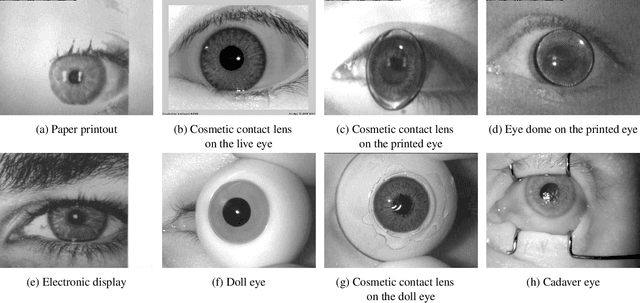


Abstract:Launched in 2013, LivDet-Iris is an international competition series open to academia and industry with the aim to assess and report advances in iris Presentation Attack Detection (PAD). This paper presents results from the fourth competition of the series: LivDet-Iris 2020. This year's competition introduced several novel elements: (a) incorporated new types of attacks (samples displayed on a screen, cadaver eyes and prosthetic eyes), (b) initiated LivDet-Iris as an on-going effort, with a testing protocol available now to everyone via the Biometrics Evaluation and Testing (BEAT)(https://www.idiap.ch/software/beat/) open-source platform to facilitate reproducibility and benchmarking of new algorithms continuously, and (c) performance comparison of the submitted entries with three baseline methods (offered by the University of Notre Dame and Michigan State University), and three open-source iris PAD methods available in the public domain. The best performing entry to the competition reported a weighted average APCER of 59.10\% and a BPCER of 0.46\% over all five attack types. This paper serves as the latest evaluation of iris PAD on a large spectrum of presentation attack instruments.
Post-Mortem Iris Recognition Resistant to Biological Eye Decay Processes
Dec 05, 2019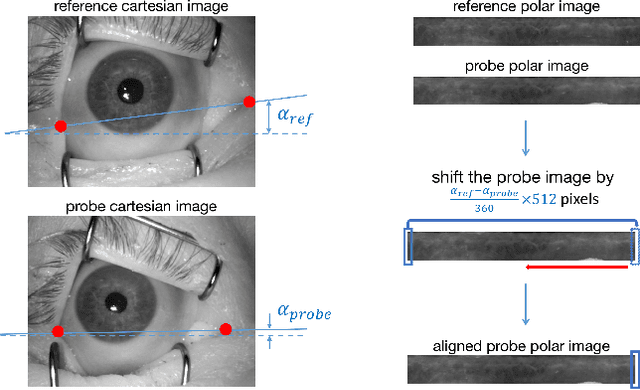

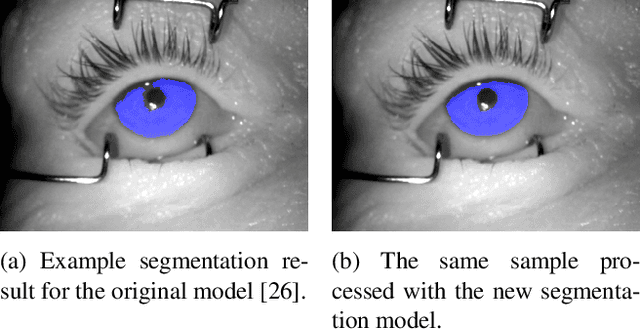
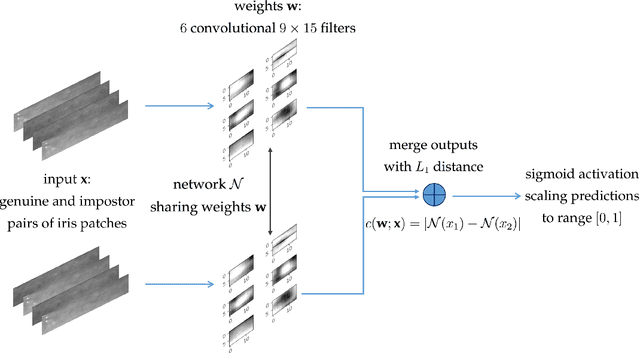
Abstract:This paper proposes an end-to-end iris recognition method designed specifically for post-mortem samples, and thus serving as a perfect application for iris biometrics in forensics. To our knowledge, it is the first method specific for verification of iris samples acquired after demise. We have fine-tuned a convolutional neural network-based segmentation model with a large set of diversified iris data (including post-mortem and diseased eyes), and combined Gabor kernels with newly designed, iris-specific kernels learnt by Siamese networks. The resulting method significantly outperforms the existing off-the-shelf iris recognition methods (both academic and commercial) on the newly collected database of post-mortem iris images and for all available time horizons since death. We make all models and the method itself available along with this paper.
Post-mortem Iris Decomposition and its Dynamics in Morgue Conditions
Nov 07, 2019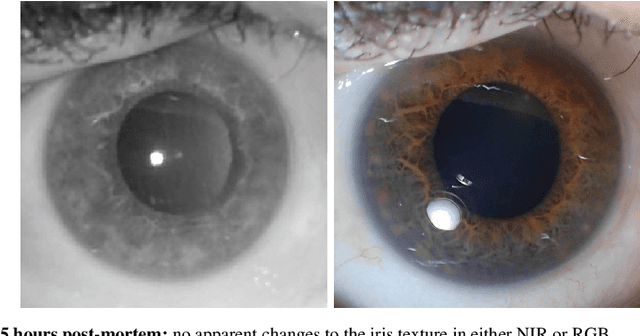
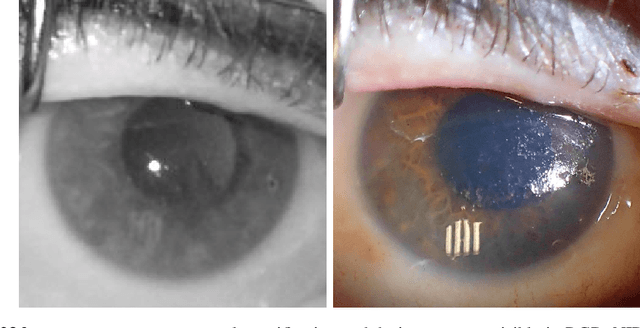
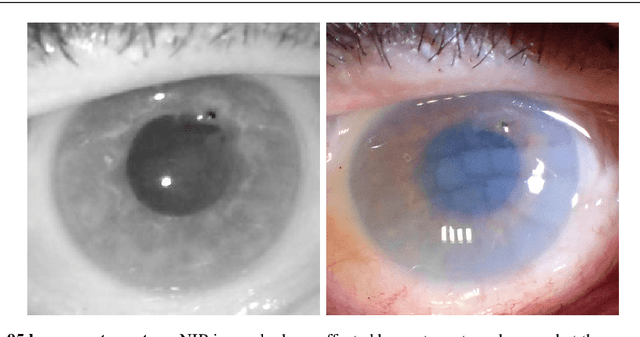
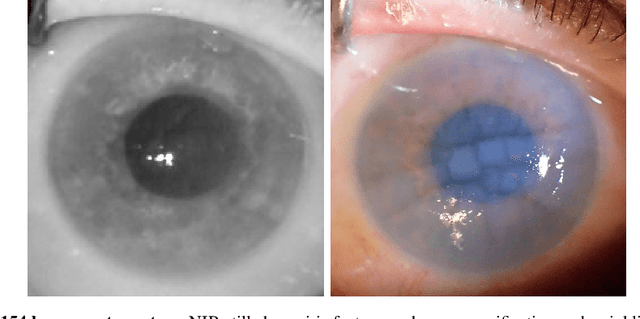
Abstract:With increasing interest in employing iris biometrics as a forensic tool for identification by investigation authorities, there is a need for a thorough examination and understanding of post-mortem decomposition processes that take place within the human eyeball, especially the iris. This can prove useful for fast and accurate matching of ante-mortem with post-mortem data acquired at crime scenes or mass casualties, as well as for ensuring correct dispatching of bodies from the incident scene to a mortuary or funeral homes. Following these needs of forensic community, this paper offers an analysis of the coarse effects of eyeball decay done from a perspective of automatic iris recognition point of view. Therefore, we analyze post-mortem iris images acquired in both visible light as well as in near-infrared light (860 nm), as the latter wavelength is used in commercial iris recognition systems. Conclusions and suggestions are provided that may aid forensic examiners in successfully utilizing iris patterns in post-mortem identification of deceased subjects. Initial guidelines regarding the imaging process, types of illumination, resolution are also given, together with expectations with respect to the iris features decomposition rates.
Post-mortem Iris Recognition with Deep-Learning-based Image Segmentation
Jan 07, 2019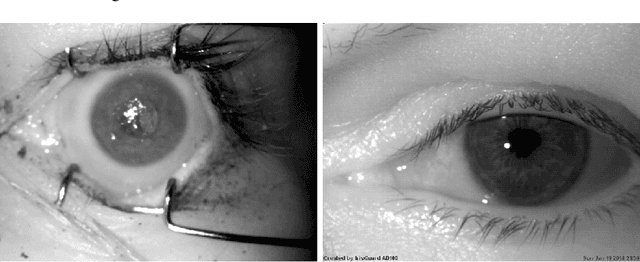
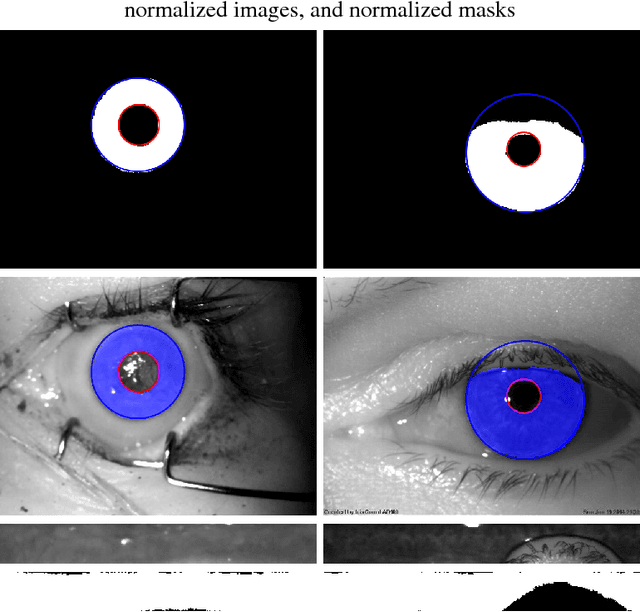
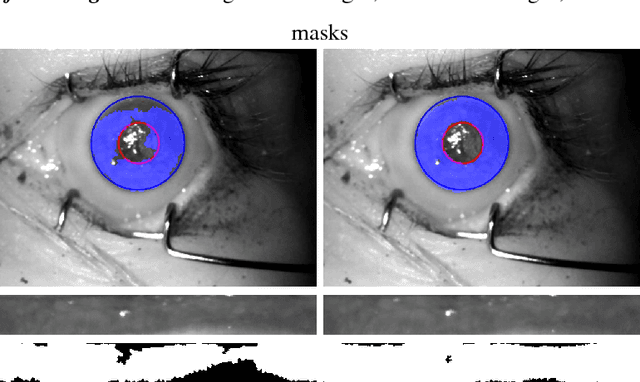

Abstract:This paper proposes the first known to us iris recognition methodology designed specifically for post-mortem samples. We propose to use deep learning-based iris segmentation models to extract highly irregular iris texture areas in post-mortem iris images. We show how to use segmentation masks predicted by neural networks in conventional, Gabor-based iris recognition method, which employs circular approximations of the pupillary and limbic iris boundaries. As a whole, this method allows for a significant improvement in post-mortem iris recognition accuracy over the methods designed only for ante-mortem irises, including the academic OSIRIS and commercial IriCore implementations. The proposed method reaches the EER less than 1% for samples collected up to 10 hours after death, when compared to 16.89% and 5.37% of EER observed for OSIRIS and IriCore, respectively. For samples collected up to 369 hours post-mortem, the proposed method achieves the EER 21.45%, while 33.59% and 25.38% are observed for OSIRIS and IriCore, respectively. Additionally, the method is tested on a database of iris images collected from ophthalmology clinic patients, for which it also offers an advantage over the two remaining methods. This work is the first step towards post-mortem-specific iris recognition, which increases the chances of identification of deceased subjects in forensic investigations. The new database of post-mortem iris images acquired from 42 subjects, as well as the deep learning-based segmentation models are made available along with the paper, to ensure all the results presented in this manuscript are reproducible.
Iris Recognition After Death
Oct 31, 2018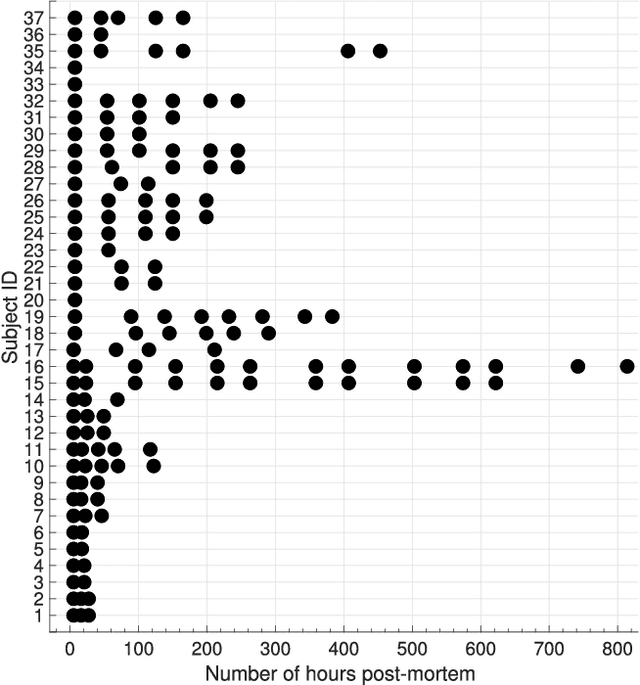

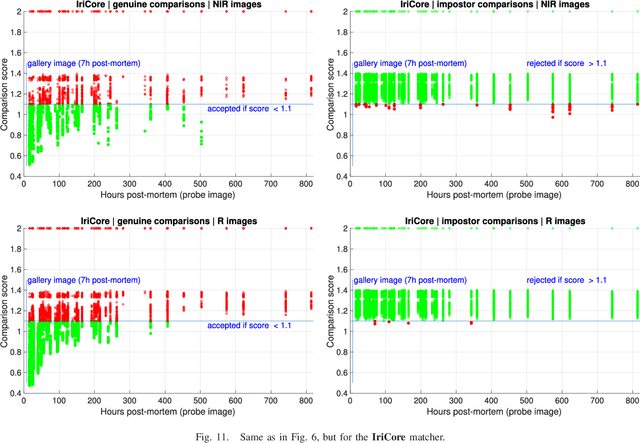

Abstract:This paper presents a comprehensive study of post-mortem human iris recognition carried out for 1,200 near-infrared and 1,787 visible-light samples collected from 37 deceased individuals kept in the mortuary conditions. We used four independent iris recognition methods (three commercial and one academic) to analyze genuine and impostor comparison scores and check the dynamics of iris quality decay over a period of up to 814 hours after death. This study shows that post-mortem iris recognition may be close-to-perfect approximately 5 to 7 hours after death and occasionally is still viable even 21 days after death. These conclusions contradict the statements present in past literature that the iris is unusable as a biometrics shortly after death, and show that the dynamics of post-mortem changes to the iris that are important for biometric identification are more moderate than previously hypothesized. The paper contains a thorough medical commentary that helps to understand which post-mortem metamorphoses of the eye may impact the performance of automatic iris recognition. We also show that post-mortem iris recognition works equally well for images taken in near-infrared and when the red channel of visible-light sample is used. However, cross-wavelength matching presents significantly worse performance. This paper conforms to reproducible research and the database used in this study is made publicly available to facilitate research of post-mortem iris recognition. To our knowledge, this paper offers the most comprehensive evaluation of post-mortem iris recognition and the largest database of post-mortem iris images.
Iris recognition in cases of eye pathology
Sep 04, 2018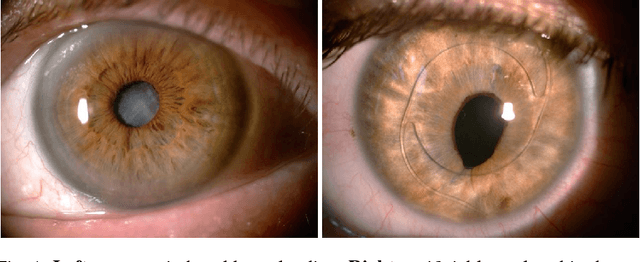
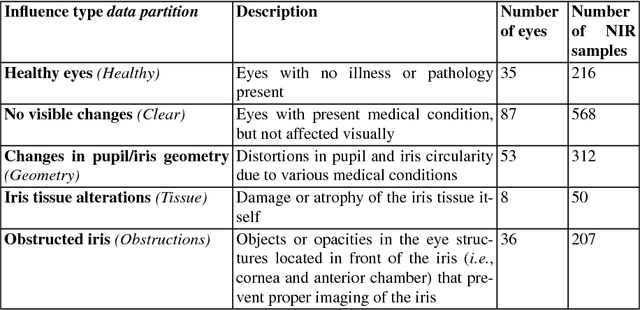
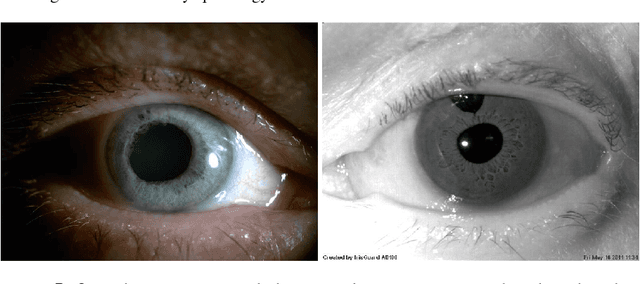
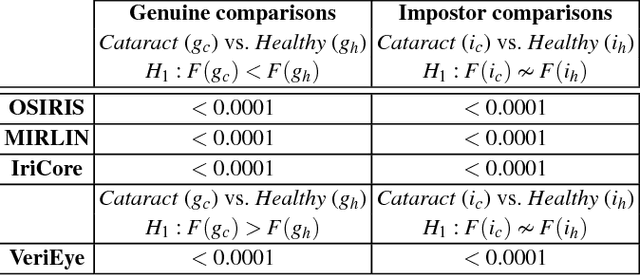
Abstract:This chapter provides insight on how iris recognition, one of the leading biometric identification technologies in the world, can be impacted by pathologies and illnesses present in the eye, what are the possible repercussions of this influence, and what are the possible means for taking such effects into account when matching iris samples. To make this study possible, a special database of iris images has been used, representing more than 20 different medical conditions of the ocular region (including cataract, glaucoma, rubeosis iridis, synechiae, iris defects, corneal pathologies and other) and containing almost 3000 samples collected from 230 distinct irises. Then, with the use of four different iris recognition methods, a series of experiments has been conducted, concluding in several important observations. One of the most popular ocular disorders worldwide - the cataract - is shown to worsen genuine comparison scores when results obtained from cataract-affected eyes are compared to those coming from healthy irises. An analysis devoted to different types of impact on eye structures caused by diseases is also carried out with significant results. The enrollment process is highly sensitive to those eye conditions that make the iris obstructed or introduce geometrical distortions. Disorders affecting iris geometry, or producing obstructions are exceptionally capable of degrading the genuine comparison scores, so that the performance of the entire biometric system can be influenced. Experiments also reveal that imperfect execution of the image segmentation stage is the most prominent contributor to recognition errors.
Database of iris images acquired in the presence of ocular pathologies and assessment of iris recognition reliability for disease-affected eyes
Sep 01, 2018


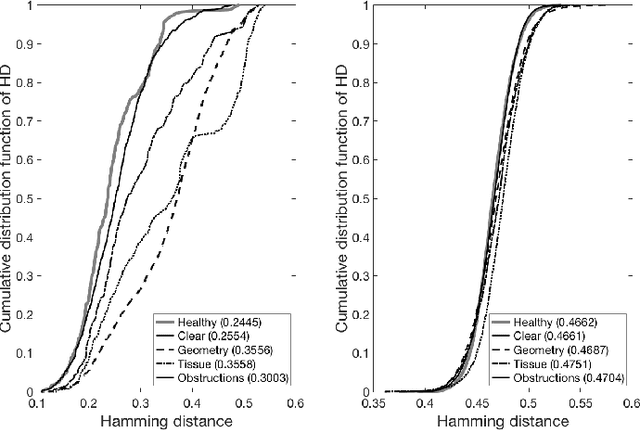
Abstract:This paper presents a database of iris images collected from disease affected eyes and an analysis related to the influence of ocular diseases on iris recognition reliability. For that purpose we have collected a database of iris images acquired for 91 different eyes during routine ophthalmology visits. This collection gathers samples for healthy eyes as well as those with various eye pathologies, including cataract, acute glaucoma, posterior and anterior synechiae, retinal detachment, rubeosis iridis, corneal vascularization, corneal grafting, iris damage and atrophy and corneal ulcers, haze or opacities. To our best knowledge this is the first database of such kind that will be made publicly available. In the analysis the data were divided into five groups of samples presenting similar anticipated impact on iris recognition: 1) healthy (no impact), 2) unaffected, clear iris (although the illness was detected), 3) geometrically distorted irides, 4) distorted iris tissue and 5) obstructed iris tissue. Three different iris recognition methods (MIRLIN, VeriEye and OSIRIS) were then used to find differences in average genuine and impostor comparison scores calculated for healthy eyes and those impacted by a disease. Specifically, we obtained significantly worse genuine comparison scores for all iris matchers and all disease-affected eyes when compared to a group of healthy eyes, what have a high potential of impacting false non-match rate.
Cataract influence on iris recognition performance
Sep 01, 2018Abstract:This paper presents the experimental study revealing weaker performance of the automatic iris recognition methods for cataract-affected eyes when compared to healthy eyes. There is little research on the topic, mostly incorporating scarce databases that are often deficient in images representing more than one illness. We built our own database, acquiring 1288 eye images of 37 patients of the Medical University of Warsaw. Those images represent several common ocular diseases, such as cataract, along with less ordinary conditions, such as iris pattern alterations derived from illness or eye trauma. Images were captured in near-infrared light (used in biometrics) and for selected cases also in visible light (used in ophthalmological diagnosis). Since cataract is a disorder that is most populated by samples in the database, in this paper we focus solely on this illness. To assess the extent of the performance deterioration we use three iris recognition methodologies (commercial and academic solutions) to calculate genuine match scores for healthy eyes and those influenced by cataract. Results show a significant degradation in iris recognition reliability manifesting by worsening the genuine scores in all three matchers used in this study (12% of genuine score increase for an academic matcher, up to 175% of genuine score increase obtained for an example commercial matcher). This increase in genuine scores affected the final false non-match rate in two matchers. To our best knowledge this is the only study of such kind that employs more than one iris matcher, and analyzes the iris image segmentation as a potential source of decreased reliability.
Post-mortem Human Iris Recognition
Sep 01, 2018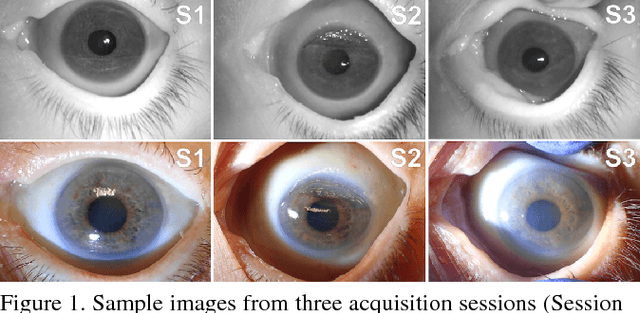
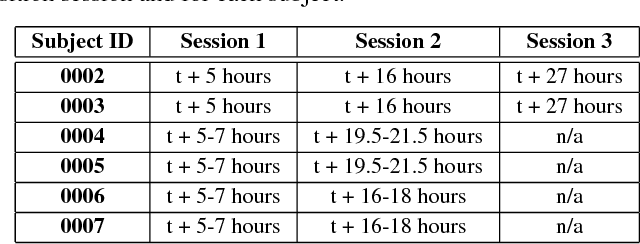
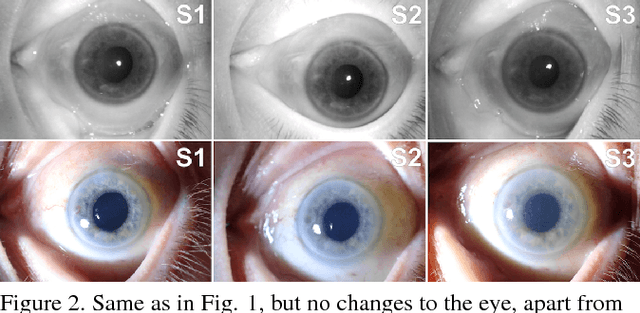

Abstract:This paper presents a unique analysis of post-mortem human iris recognition. Post-mortem human iris images were collected at the university mortuary in three sessions separated by approximately 11 hours, with the first session organized from 5 to 7 hours after demise. Analysis performed for four independent iris recognition methods shows that the common claim of the iris being useless for biometric identification soon after death is not entirely true. Since the pupil has a constant and neutral dilation after death (the so called "cadaveric position"), this makes the iris pattern perfectly visible from the standpoint of dilation. We found that more than 90% of irises are still correctly recognized when captured a few hours after death, and that serious iris deterioration begins approximately 22 hours later, since the recognition rate drops to a range of 13.3-73.3% (depending on the method used) when the cornea starts to be cloudy. There were only two failures to enroll (out of 104 images) observed for only a single method (out of four employed in this study). These findings show that the dynamics of post-mortem changes to the iris that are important for biometric identification are much more moderate than previously believed. To the best of our knowledge, this paper presents the first experimental study of how iris recognition works after death, and we hope that these preliminary findings will stimulate further research in this area.
* Accepted for publication version of the manuscript submitted for the IEEE ICB 2016
 Add to Chrome
Add to Chrome Add to Firefox
Add to Firefox Add to Edge
Add to Edge